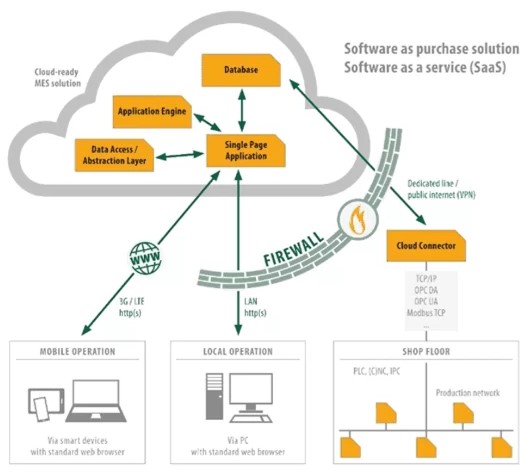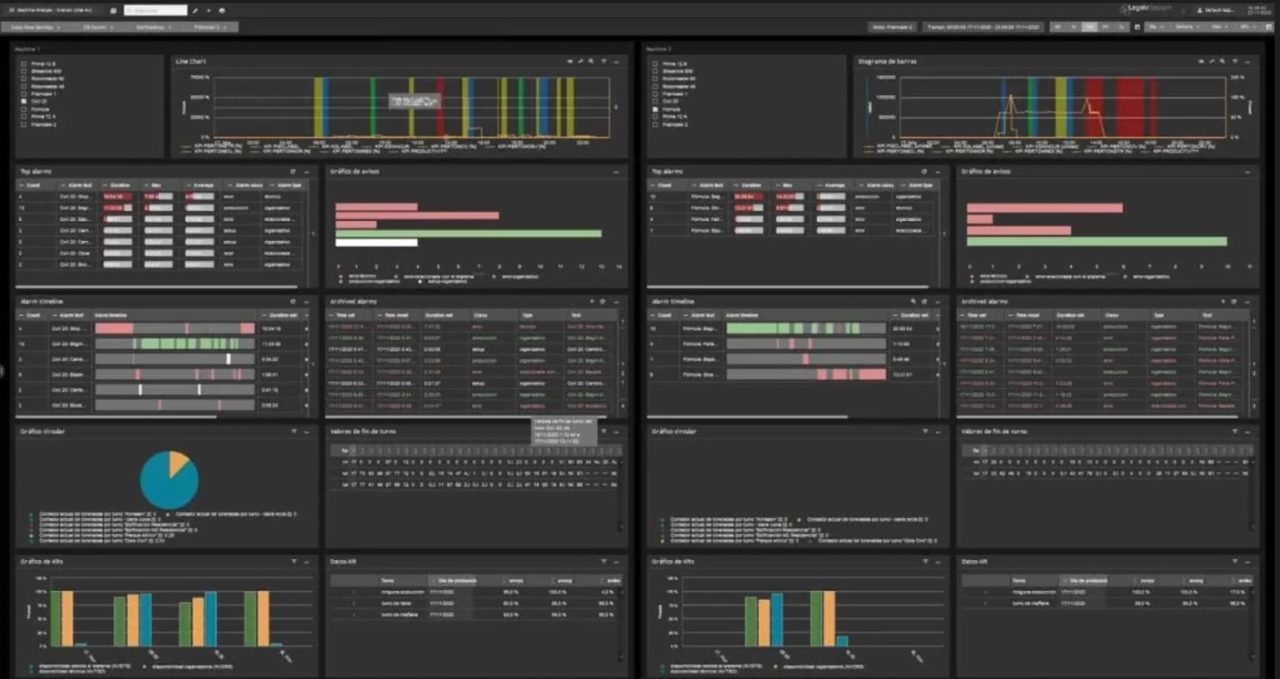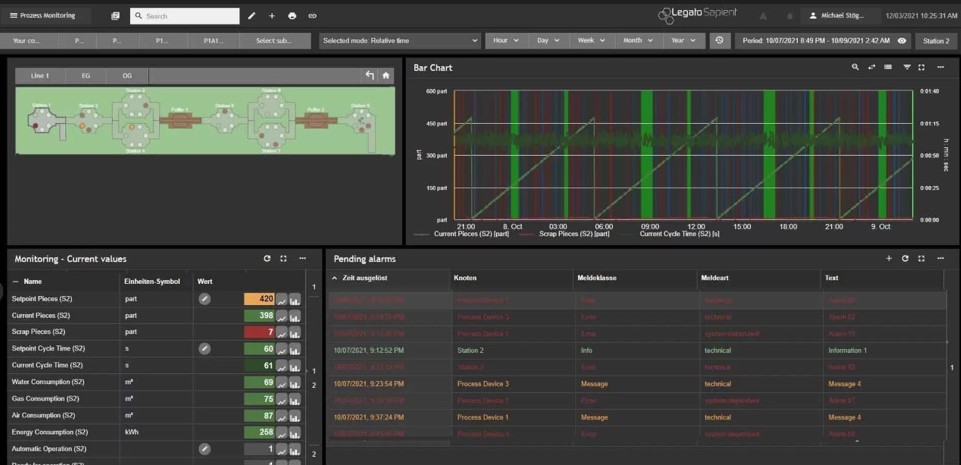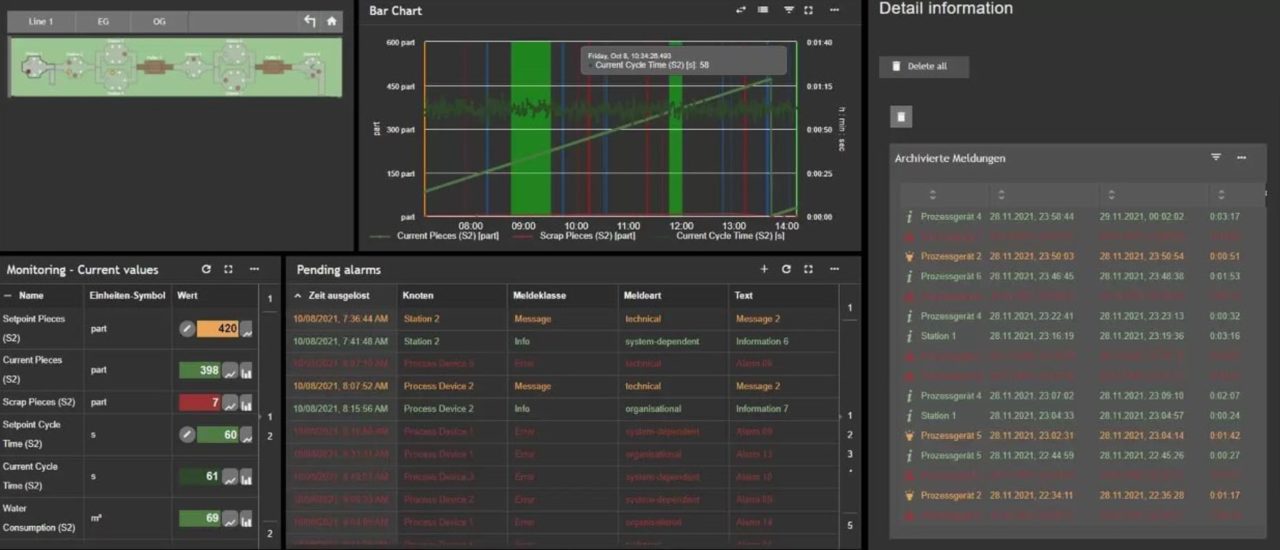Machine breakdowns or even system downtime are still a worst-case scenario in manufacturing. It stands to reason that machine maintenance is one of the key factors in making production more efficient and reducing costs.
Increase system availability through central system monitoring
The advantages of central system monitoring at a glance:

Unplanned downtimes are one of the main cost drivers, as they are often detected too late. In addition, fault descriptions are almost always missing. This means that additional time and capacity must be spent searching for the cause of the problem – because until this is known, neither the right measures can be determined nor the right contact person for central maintenance contacted.
Faster detection and rectification of unplanned plant downtimes can increase daily production by an average of ten percent.
However, central plant monitoring offers real added value not only in the event of a plant shutdown: process deviations are detected more quickly, for example in the event of creeping deterioration due to longer cycle times or slowly increasing energy consumption.

Competitive advantage thanks to central system monitoring

A system standstill inevitably leads to production backlogs and a reduction in the number of units. This can only be counteracted with overtime or the provision of reserve capacity. The costs sometimes add up to dizzying heights.
Therefore, keep the number of plant downtimes as low as possible by increasing plant availability.
Companies that implement the following four parameters are better prepared and thus create a real competitive advantage:

1. Real-time machine data acquisition (MDE)
The availability and exchange of data in real time creates transparency and is a real added value for many processes. In order to be able to react to ad hoc scenarios, the key to success lies in real-time data acquisition: this means that a failure is communicated directly and the cause is displayed. This significantly increases the ability to act as well as the speed of reaction and implementation.
2. Fast communication flow
In the event of an unplanned plant shutdown, various groups of people and sub-processes are affected. Continuous and, above all, rapid communication to all those involved is essential in order to limit the damage and maintain the highest possible production efficiency despite the outage. For example, communication can take place via notifications on the smartwatches of the responsible maintenance personnel. This creates a flow of information in near real time, regardless of where the employees are at the time of the incident.
3. System monitoring through intelligent analytics and comprehensible reports
Learning from problems is the best approach to optimization. With the help of intelligent data analysis and reporting, potential for improvement can be identified and recurring problems can be eliminated in the long term. This allows us to act and react even better in the future – in the spirit of a continuous improvement process (CIP).
4. Real-time visualization in the cross-system "Control Tower"
Centralized system monitoring in the control station provides an overview of the entire production process. With horizontal data integration, it is not just a specific system or a limited area that can be viewed. Real-time visualization and monitoring of the entire, partially interlinked process makes it possible to analyze process correlations and the effects of individual production problems.
High plant availability & optimum production efficiency
The module for central plant monitoring in our MES software solution Legato Sapient enables a machine connection for real-time data acquisition – for both homogeneous and heterogeneous machine parks across different communication variants.
Regardless of the manufacturer of the production machines, over 2,000 machines can be connected in a single system.
Machine connection: simple & flexible
Based on this machine connection, process values and fault messages can be recorded and visualized in real time. The user front end is called up via a standard web browser and can be displayed regardless of whether the information is required in the control station, via large displays, on mobile devices or on a PC.
The status of the plant, the production line or a machine can be queried at any time and from anywhere in real time.
Clear visualization in production
The graphical visualization makes it easier to identify problems, for example by schematically colouring production areas or individual systems depending on the status quo. In the event of a system downtime, machine maintenance is automatically notified – via a call system or information on the smartwatch. Automatic escalation ensures that an employee takes care of targeted maintenance.
Target/actual comparison for optimal monitoring
Thanks to the recording of process values such as quantities, cycle times or energy values in combination with continuous monitoring by means of defined target and limit values, the software solution enables optimized production efficiency beyond the event of a malfunction. Just as in the event of a standstill, the system provides information about irregularities and deviations and thus offers not only monitoring, but also the basis for optimized decision-making. This allows you to get the best out of your production.
High system availability and optimum production efficiency
The IT/OT connector is the heart of real-time machine data acquisition from the plant control systems (PLCs). Both OEE data acquisition and production control are carried out via this component. Once the data has been recorded via the IT/OT connector, it is processed further or displayed in the web visualization.
In the case of central system monitoring, there are generally two use cases:
- Recognizing and stopping gradual process deterioration (e.g. when cycle times slowly deteriorate)
- Detecting and rectifying system downtimes
Graphic visualizations are often used to detect system downtimes, whether as a large display in production (ANDON), in the control station or in a maintenance office.
Real-time visualization for “error-driven drilldowns”
Depending on the application, different levels/depths of detail are used. Within a plant, we typically distinguish between four levels:
Level 1: Layout for production and plant managers
The so-called plant overview shows the top level with color coding of the individual areas. The color code represents the target/actual comparison of quantities and thus provides an optimal overview of the performance within the production areas. This layout is therefore very helpful for production or plant managers.
Level 2: Representation for production or maintenance managers
This is the display level for a production or maintenance manager of a plant or segment. In this case, the corresponding segment is displayed divided into areas, with the rectangular boxes each representing the “issuing” plant of an area. The round shapes visualize the various MES buffers including fill level and limit values. This view already contains a number of relevant “vital values” for the individual areas, such as the type of malfunction or number of units achieved (target/actual comparison).
Level 3: Display for line managers or foremen
This display level is aimed at a line manager or foreman. In this case, the corresponding production area is displayed subdivided by plant, with the rectangular boxes representing the plants and the round shapes again visualizing the MES buffers. The display of the information is consistent with the higher-level view.
Level 4: Display for plant operators
The most detailed display is designed for a plant operator. In this case, the corresponding system and its robots are displayed. In addition to the display of the robots, other relevant status information from safety doors or light barriers is visualized.
Evaluating process deviations with visualization in production
If the plant has not yet come to a standstill, there is still a risk that the process is slowly “getting out of hand”. The Legato Sapient MES software helps you to detect process deviations at an early stage.
You can use the dashboard below to identify and correct process deviations in good time. In the top right-hand section, deviations can be detected on the basis of the piece count history if the current actual piece count is below the current target piece count.
For more detailed analyses in relation to the quantities, zoom into the diagram at the time of the deviation and click to open the sidebar with further analyses. The associated disruptions for the selected period (zoom area in the diagram) are shown below:
The user frontend contains numerous options for interacting with the data presented. This ensures maximum flexibility for detailed analyses and ultimately high plant availability and overall equipment effectiveness (OEE).
FAQ: Important questions about system availability
What does system availability mean?
The term system availability refers to a target/actual comparison. It indicates what percentage of the time a system has actually produced compared to the planned production time. Machine availability is the analogous term for machines.
What constitutes good system availability?
Plant availability is often expressed by the OEE indicator. If the available capacities are not being used optimally – which is indicated by a value of less than 65% – the production process and efficiency should be optimized: Downtimes and error states of the production equipment should be analyzed urgently and thoroughly. If the value is above 65%, plant availability is good. However, there is long-term optimization potential for almost every system.
What does OEE stand for and how is this key figure determined?
OEE is the abbreviation for Overall Equipment Effectiveness. In German, the abbreviation GAE is also used for overall equipment effectiveness. The OEE value is made up of the product of three factors:
- Plant availability,
- performance (degree of utilization) and
- quality
It theoretically ranges between 0% and 100%.
Why is it important to increase system availability?
Companies can use the OEE key figures to identify optimization potential for plant availability and make decisions based on solid indicators.
The aim of increasing plant availability is to avoid unplanned downtime, rejects and rework. This enables you to identify inefficient production areas and their causes and use this transparency to derive effective measures to systematically increase productivity.







